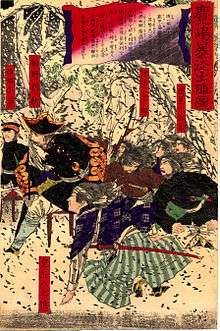Kirino Toshiaki
| Kirino Toshiaki | |
|---|---|
 Kirino Toshiaki | |
| Nickname(s) | Hitokiri Hanjirō (Hanjiro the Assassin) |
| Born |
December 1838 Kagoshima, Japan |
| Died |
September 24, 1877 Kagoshima, Japan |
| Allegiance | Empire of Japan |
| Service/branch |
|
| Years of service | 1868-1876 |
| Rank | Major General |
| Battles/wars | Kinmon Incident, Battle of Aizu, Satsuma Rebellion |
Kirino Toshiaki (桐野 利秋, December 1838 – September 24, 1877) was a Japanese samurai of the late Edo period, and an Imperial Japanese Army general of the early Meiji era.
Biography
Kirino, also known as Nakamura Hanjirō (中村 半次郎), was renowned as one of the Four Hitokiri of the Bakumatsu. His sword style was Ko-jigen-ryū, a branch of the high-speed Jigen-ryū . Kirino's activities during the early to mid-1860s largely centered on Kyoto. During the Boshin War, as a senior commander of Satsuma forces, he was a high-ranking officer of the new Imperial Army. It was Kirino who was the representative of the imperial army at the surrender of Wakamatsu Castle, where he received the petition for surrender from Matsudaira Katamori, the lord of Aizu.
Kirino became a brigadier general in the early years of the Imperial Japanese Army. However, he joined the forces of Saigō Takamori during the Satsuma Rebellion, taking part in the march northward to Kumamoto. Kirino remained with Saigō until the end, and was killed at the end of the rebellion.

A lover of French Eau de Cologne, Kirino wore it even during his last battle at Shiroyama.
Kirino's wife, Hisa, was a skilled martial artist. As seen in several contemporary woodblock prints depicting the uprising, she also joined in its march. Unlike her husband, she survived, and lived until 1920.
Cultural references
Kirino appears as a character in the history-themed Getsumei Seiki, by Kenji Morita. Kirino also appears as the Army Commander in the manga RED: Livin' on The Edge, by Kenichi Muraeda.
References
- Mossman, Samuel (1880). Japan. (London: Sampson Low, Marston, Searle, & Rivington), p. 96.
- (Japanese) Information on the Satsuma Rebellion (3 Oct. 2007)
External links
- (Japanese) Photos of the graves of the Satsuma Rebellion leaders, including Kirino (3 Oct. 2007)
Further reading
- Nagano Ōgaku 長野桜岳 (1972). Kirino Toshiaki 桐野利秋. Tokyo: Shin Jinbutsu Ōraisha.